Distinguished Military Unit: 761st Tank Battalion

Army Together We Served currently records eight remembrances for members of the 761st Tank Battalion "Black Panthers":
Bates, Paul Levern, COL
Connelly, William A., SMA
Crecy, Warren G.H., MAJ
Jenkins, Earnest, PVT
Johnson, Lloyd, SGT
Mills, Earl F., CW4
Rivers, Ruben, S/SGT (MOH)
Robinson, Jack Roosevelt (Jackie), 2LT
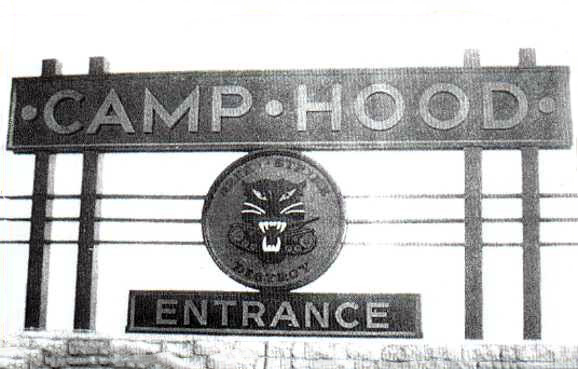 On January 14, 1942, at the beginning of the United States' involvement in World War II, it was announced that a Tank Destroyer Tactical and Firing Center would be established near Killeen, Texas. The 761st tank battalion was constituted on March 15, 1942, and activated in April at Camp Claiborne, LA. On November 21, 1941, General Marshall ordered the Tank Destroyer Force, developed by the Army Ground Force's General Leslie J. McNair, to be implemented at Camp Hood, Texas. They were charged with the mission to SEEK, STRIKE, and DESTROY enemy tanks. Camp Hood (later Fort Hood, now Fort Cavazos) is located in southwestern Bell and southeastern Coryell counties of Central Texas. Most of the 218,000 acres owned by the United States Army are located in Coryell County. The now famous Tank Destroyer SSI and 761st DUI were contemporaneous emblems. The black cat eating a tank was officially adopted for use by the 3rd Squadron of the 71st Cavalry Regiment, designed while at Camp Hood in 1944-45.
On January 14, 1942, at the beginning of the United States' involvement in World War II, it was announced that a Tank Destroyer Tactical and Firing Center would be established near Killeen, Texas. The 761st tank battalion was constituted on March 15, 1942, and activated in April at Camp Claiborne, LA. On November 21, 1941, General Marshall ordered the Tank Destroyer Force, developed by the Army Ground Force's General Leslie J. McNair, to be implemented at Camp Hood, Texas. They were charged with the mission to SEEK, STRIKE, and DESTROY enemy tanks. Camp Hood (later Fort Hood, now Fort Cavazos) is located in southwestern Bell and southeastern Coryell counties of Central Texas. Most of the 218,000 acres owned by the United States Army are located in Coryell County. The now famous Tank Destroyer SSI and 761st DUI were contemporaneous emblems. The black cat eating a tank was officially adopted for use by the 3rd Squadron of the 71st Cavalry Regiment, designed while at Camp Hood in 1944-45.
Throughout its history, about 710 soldiers were officially assigned to the Battalion. Twenty-four were KIA, 84 WIA, and 44 MIA from that roster. They arrived at Saint-Nicholas, France, in October 1944, saw first action on November 8, and endured 183 total days of battle, liberating thirty towns in six countries, including helping capture Goering's castle, until deactivated in 1946 – decades before the 21st century Black Panther movie superhero or mid-1960s advent of the Black Panther Party. These stereotypically gruff words from Third Army Commander Lt. Gen. George Patton was their welcome in their vital mission in defeating Nazi Germany in WWII: "Men, you're the first Negro tankers to ever fight in the American Army. I would never have asked for you if you weren't good. I have nothing but the best in my Army. I don't care what color you are as long as you go up there and kill those Kraut sons of bitches. Everyone has their eyes on you and is expecting great things from you. Most of all, your race is looking forward to you. Don't let them down, and damn you, don't let me down!"
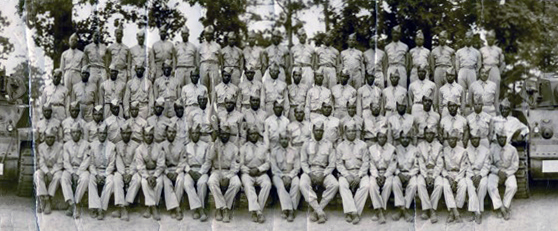 Kareem Abdul-Jabbar, who authored the book "Brothers in Arms: The Epic Story of the 761st Tank Battalion, WWII's Forgotten Heroes," wrote of them: "Certainly, they were General Patton's most effective unit… Because they were a replacement unit, they often shifted around to different areas. In every instance, their presence meant that competent tank support had arrived. The commander of the 17th Airborne, Gen. John Miley, felt that he could send many more of his Soldiers home alive as a direct result of the effective support of the 761st."
Kareem Abdul-Jabbar, who authored the book "Brothers in Arms: The Epic Story of the 761st Tank Battalion, WWII's Forgotten Heroes," wrote of them: "Certainly, they were General Patton's most effective unit… Because they were a replacement unit, they often shifted around to different areas. In every instance, their presence meant that competent tank support had arrived. The commander of the 17th Airborne, Gen. John Miley, felt that he could send many more of his Soldiers home alive as a direct result of the effective support of the 761st."
In early 1942, the Battalion began training in M5 Stuart light tanks. They learned to maneuver, mount, dismount, and maintain the vehicle's 37 mm main gun and .30 caliber machine guns. The Battalion was eventually moved to Camp Hood, Texas, where they would train for over two years. The men trained in M4 Sherman medium tanks and again in the M5 Stuart light tank. After a brief deployment to England, the 761st landed in France via Omaha Beach. From the time they entered combat until the end of the war in Europe, the men of the 761st received seven Silver Stars, 246 Purple Hearts, and one Congressional Medal of Honor. The Battalion would play a major role in the bitter Battle of the Bulge as the German's last-ditch offensive was successfully countered. Afterward, the Panthers opened the way for the US 4th Armored Division into Germany during an action that breached the Siegfried Line. The 761st helped break out and rescue the encircled American Army of Bastogne.
By the end of April 1945, the unit would be among the earliest US battalions to meet up with Soviet forces. In the final days of the war in Europe, the 761st was one of the first American units to reach Steyr, Austria, at the Enns River, where they met with the 1st Ukrainian Front of the Soviet Red Army. The convergence of the Russian and US armies split the final remnants of the Wehrmacht in two, hastening an end to World War II in Europe. The 761st would remain in Germany for another year before being deactivated on June 1, 1946, and sent home. It would be another three years until the US armed forces began integrating when then-President Harry S. Truman signed Executive Order 9981 on July 26, 1948. In its history, the Battalion had 30-36 black officers, six white officers, and 676 enlisted men by 1942. After the war, the Army awarded the unit with four campaign ribbons. President Jimmy Carter awarded the Battalion a Presidential Unit Citation for Extraordinary Heroism.
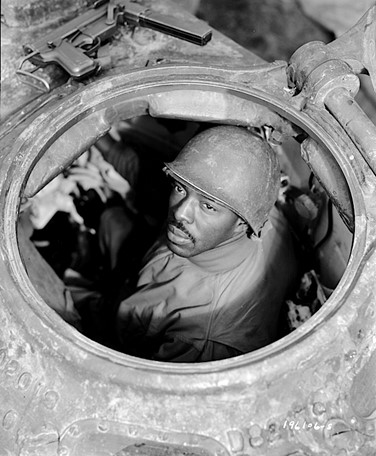 Sgt. Ruben Rivers of the 761st was posthumously awarded the Medal of Honor on January 13, 1997, by President Bill Clinton. The award was presented to Rivers' sister, Grace Wood, ford in attendance that day at the White House. His citation reads:
Sgt. Ruben Rivers of the 761st was posthumously awarded the Medal of Honor on January 13, 1997, by President Bill Clinton. The award was presented to Rivers' sister, Grace Wood, ford in attendance that day at the White House. His citation reads:
"For conspicuous gallantry and intrepidity at the risk of his life above and beyond the call of duty: Staff Sergeant Rivers distinguished himself by extraordinary heroism in action during 16-19 November 1944, while serving with Company A, 761st Tank Battalion. On November 16, 1944, while advancing toward Guébling, France, Staff Sergeant Rivers' tank hit a mine at a railroad crossing. Although severely wounded, his leg slashed to the bone, Staff Sergeant Rivers declined an injection of morphine, refused to be evacuated, took command of another tank, and advanced with his company into Guébling the next day. Repeatedly refusing evacuation, Staff Sergeant Rivers continued to direct his tank's fire at enemy positions beyond the town through the morning of November 19, 1944. At dawn that day, Company A's tanks advanced toward Bourgaltoff, their next objective, but were stopped by enemy fire. Captain David J. Williams, the Company Commander, ordered his tanks to withdraw and take cover. Staff Sergeant Rivers, however, radioed that he had spotted the German antitank positions: "I see 'em. We'll fight 'em!" Staff Sergeant Rivers, joined by another Company A tank, opened fire on enemy tanks, covering Company A as they withdrew. While doing so, Staff Sergeant Rivers' tank was hit, killing him and wounding the rest of the crew. Staff Sergeant Rivers' fighting spirit and daring leadership were an inspiration to his unit and exemplify the highest traditions of military service."
Jackie Robinson was drafted on April 3, 1942, and was assigned to a cavalry unit at Fort Riley, Kansas. While there, with help and encouragement from Private Joe "Brown Bomber" Louis, the college-educated Corporal Robinson applied for Officers' Candidate School. Although the Army officially supported the training of black officers, few thus far had gained admittance to Fort Riley OCS. Lieutenant Jack "Jackie" Roosevelt Robinson of the 761st, an athlete who would become one of the greatest baseball players and Dodgers of all time, lost his chance to see combat when he refused to move to the back of a segregated military bus during an incident at Camp Hood, Texas in July 1944. The 761st Battalion's commander, Lt. Col. Paul L. Bates, refused to prosecute Robinson, but his superiors got around that by transferring the lieutenant to another unit, where he was court-martialed. Robinson was later acquitted, but too late to rejoin his previous unit.
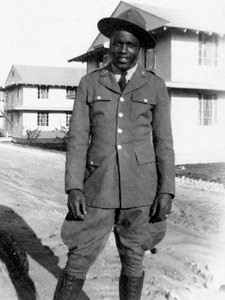 Jackie, Fort Riley 1942
Jackie, Fort Riley 1942
The 761st A Company Capt. John B. Long proudly summed up his pride for the Black Panthers and their conduct. "Not for God and country but for me and my people," he said. "This was my motivation, pure and simple when I entered the Army. I swore to myself there would never be a headline saying my men and I chickened. A soldier, in time of war, is supposed to accept the idea of dying. That's what he's there for: live with it and forget it. I expected to get killed, but whatever happened, I was determined to die an officer and a gentleman. . . . The town of Morville-les-Vic was supposed to be a snap, but it was an inferno; my men were tigers, and they fought like seasoned veterans. We got our lumps, but we took that f***ing town."
In May 1945, the Black Panthers were part of the Allied forces that liberated Gunskirchen, a subcamp of the Mauthausen concentration camp. One woman liberated by the unit, 17-year-old Sonia Schreiber Weitz, described the soldier who saved her in a poem, "The Black Messiah."
A black GI stood by the door
(I never saw a black before.)
He'll set me free before I die,
I thought he must be the Messiah.
A black Messiah came for me . . .
He stared with eyes that didn't see,
He never heard a single word
Which hung absurd upon my tongue.
And then he simply froze in place
The shock, the horror on his face,
He didn't weep, he didn't cry
But deep within his gentle eyes
. . . A flood of devastating pain,
his innocence forever slain.
For me, with yet another dawn
I found my black Messiah gone
And on we went our separate ways
For many years without a trace.
But there's a special bond we share
Which has grown strong because we dare
To live, to hope, to smile…and yet
We vow not ever to forget.
Sonia was 16 years old when US troops liberated her and her sister Blanca, together with circa 85,000 other prisoners, from Mauthausen. Sonia and Blanca spent three years in a displaced persons camp after the war, waiting for relatives to claim them, but no other family members survived. Along that same line, Anthony Blinken, our current US Secretary of State, recounted that his own stepfather, Samuel Pisar, was also rescued from the Holocaust by the 761st as they moved into the region. "'He ran to the tank. The hatch opened. An African American GI looked down at him. He fell to his knees and said the only three words he knew in English that his mother had taught him: 'God Bless America.' The GI lifted him into the tank, into America, into freedom." Blinken's half-sister, Leah Pisar, said that the soldier's name was Sgt. Bill Ellington. Samuel, an attorney who advised American and French presidents in the 1960s and 1970s, was one of the youngest survivors of a concentration camp in occupied Poland.
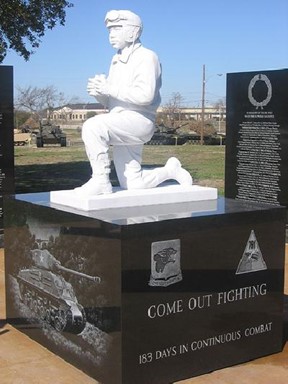 A monument featuring the kneeling Sgt. Ruben Rivers and, dedicated to the 761st, was unveiled at Fort Cavazos, Texas, during a ceremony attended by surviving veterans on November 10, 2005, as a "… permanent tribute to soldiers who had served and continued to serve throughout the world for liberty, honor, and democracy." Another marble panel with French text inscription was placed in the town of Morville-les-Vic dedicated to twelve soldiers of the 761st Tank Battalion who lost their lives in the town's liberation and are named on it. A third memorial for the Black Panthers, who were attached to the 87th Infantry Division while fighting during the Battle of the Bulge in 1944/45, was dedicated in the Belgian town of Tillet in 2021. And today, there's a bronze one at Camp Claiborne, too.
A monument featuring the kneeling Sgt. Ruben Rivers and, dedicated to the 761st, was unveiled at Fort Cavazos, Texas, during a ceremony attended by surviving veterans on November 10, 2005, as a "… permanent tribute to soldiers who had served and continued to serve throughout the world for liberty, honor, and democracy." Another marble panel with French text inscription was placed in the town of Morville-les-Vic dedicated to twelve soldiers of the 761st Tank Battalion who lost their lives in the town's liberation and are named on it. A third memorial for the Black Panthers, who were attached to the 87th Infantry Division while fighting during the Battle of the Bulge in 1944/45, was dedicated in the Belgian town of Tillet in 2021. And today, there's a bronze one at Camp Claiborne, too.
During their combat history, they had advanced with the 409th ID and been attached to:
Third Army:
4th Armored Division (United States)
1st, 26th, 71st and 87th Infantry Divisions
17th Airborne Division (United States)
17th Armored Group
Seventh Army:
1st and 103rd Infantry Divisions
Ninth Army:
79th and 95th Infantry Divisions
XVI Corps
Among many books that mention the 761st in order of battle chronology, nine more extensive narratives have been published featuring the unit. As much as other documentary and video productions, actor and USAF veteran Morgan Freeman, who had originally pitched the story to Steven Spielberg, inspired and, with 761st historian Wayne Robinson, narrated a two-hour cultural awareness film, 761st Tank Battalion: The Original Black Panthers, which premiered August 20 2023 on The History Channel. Freeman said, "The main thing about doing anything like this is to open the doors of American history as part of who we are as a people. Believe us when we tell you, there was nothing anybody, any group, has done that we weren't involved in making this country – this country… it's your story, and if it needs telling, nobody else is gonna tell your story. They tell their own story. So if you want yours told, you got to tell it yourself. So here we are."